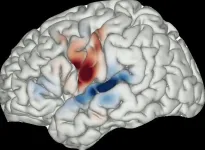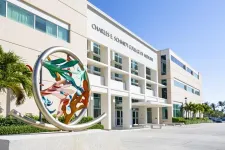(Press-News.org) CAMBRIDGE, MA -- Gastric balloons — silicone balloons filled with air or saline and placed in the stomach — can help people lose weight by making them feel too full to overeat. However, this effect eventually can wear off as the stomach becomes used to the sensation of fullness.
To overcome that limitation, MIT engineers have designed a new type of gastric balloon that can be inflated and deflated as needed. In an animal study, they showed that inflating the balloon before a meal caused the animals to reduce their food intake by 60 percent.
This type of intervention could offer an alternative for people who don’t want to undergo more invasive treatments such as gastric bypass surgery, or people who don’t respond well to weight-loss drugs, the researchers say.
“The basic concept is we can have this balloon that is dynamic, so it would be inflated right before a meal and then you wouldn't feel hungry. Then it would be deflated in between meals,” says Giovanni Traverso, an associate professor of mechanical engineering at MIT, a gastroenterologist at Brigham and Women’s Hospital, and the senior author of the study.
Neil Zixun Jia, who received a PhD from MIT in 2023, is the lead author of the paper, which appears today in the journal Device.
An inflatable balloon
Gastric balloons filled with saline are currently approved for use in the United States. These balloons stimulate a sense of fullness in the stomach, and studies have shown that they work well, but the benefits are often temporary.
“Gastric balloons do work initially. Historically, what has been seen is that the balloon is associated with weight loss. But then in general, the weight gain resumes the same trajectory,” Traverso says. “What we reasoned was perhaps if we had a system that simulates that fullness in a transient way, meaning right before a meal, that could be a way of inducing weight loss.”
To achieve a longer-lasting effect in patients, the researchers set out to design a device that could expand and contract on demand. They created two prototypes: One is a traditional balloon that inflates and deflates, and the other is a mechanical device with four arms that expand outward, pushing out an elastic polymer shell that presses on the stomach wall.
In animal tests, the researchers found that the mechanical-arm device could effectively expand to fill the stomach, but they ended up deciding to pursue the balloon option instead.
“Our sense was that the balloon probably distributed the force better, and down the line, if you have balloon that is applying the pressure, that is probably a safer approach in the long run,” Traverso says.
The researchers’ new balloon is similar to a traditional gastric balloon, but it is inserted into the stomach through an incision in the abdominal wall. The balloon is connected to an external controller that can be attached to the skin and contains a pump that inflates and deflates the balloon when needed. Inserting this device would be similar to the procedure used to place a feeding tube into a patient’s stomach, which is commonly done for people who are unable to eat or drink.
“If people, for example, are unable to swallow, they receive food through a tube like this. We know that we can keep tubes in for years, so there is already precedent for other systems that can stay in the body for a very long time. That gives us some confidence in the longer-term compatibility of this system,” Traverso says.
Reduced food intake
In tests in animals, the researchers found that inflating the balloon before meals led to a 60 percent reduction in the amount of food consumed. These studies were done over the course of a month, but the researchers now plan to do longer-term studies to see if this reduction leads to weight loss.
“The deployment for traditional gastric balloons is usually six months, if not more, and only then you will see good amount of weight loss. We will have to evaluate our device in a similar or longer time span to prove it really works better,” Jia says.
If developed for use in humans, the new gastric balloon could offer an alternative to existing obesity treatments. Other treatments for obesity include gastric bypass surgery, “stomach stapling” (a surgical procedure in which the stomach capacity is reduced), and drugs including GLP-1 receptor agonists such as semaglutide.
The gastric balloon could be a good option for patients who are not good candidates for surgery or don’t respond well to weight-loss drugs, Traverso says.
“For certain patients who are higher-risk, who cannot undergo surgery, or did not tolerate the medication or had some other contraindication, there are limited options,” he says. “Traditional gastric balloons are still being used, but they come with a caveat that eventually the weight loss can plateau, so this is a way of trying to address that fundamental limitation.”
###
The research was funded by MIT’s Department of Mechanical Engineering, the Karl van Tassel Career Development Professorship, the Whitaker Health Sciences Fund Fellowship, the T.S. Lin Fellowship, the MIT Undergraduate Research Opportunities Program, and the Boston University Yawkey Funded Internship Program.
END
An inflatable gastric balloon could help people lose weight
The new balloon can be expanded before a meal to prevent overeating, then deflated when no longer needed
2024-12-03
ELSE PRESS RELEASES FROM THIS DATE:
PCORI commits $156 million to new patient-centered health research studies
2024-12-03
WASHINGTON, D.C. — The Patient-Centered Outcomes Research Institute (PCORI) has approved funding awards totaling more than $156 million for new patient-centered comparative clinical effectiveness research (CER), as well as research to improve methods and strengthen the science of engagement in CER. The awards will support 13 CER studies, including three focused on sleep interventions.
“Poor sleep affects more than 50 million people in the United States and is linked to multiple chronic conditions and negative health outcomes,” said PCORI Executive Director Nakela L. Cook, M.D., MPH. “These ...
Debra Bangasser honored with prestigious research award
2024-12-03
ATLANTA — Debra Bangasser, a professor of neuroscience and director of the Center for Behavioral Neuroscience (CBN) at Georgia State University, has been awarded the Daniel H. Efron Research Award by the American College of Neuropsychopharmacology (ACNP).
The award recognizes outstanding basic research contributions to the field of neuropsychopharmacology, which integrates neuroscience and pharmacology to advance understanding of the causes of psychiatric disorders and develop new therapies. Bangasser’s research identifies how stress throughout the lifespan affects the brain to promote ...
The Paul G. Allen Family Foundation awards $9 million to new Allen Distinguished Investigators
2024-12-03
SEATTLE, WASH.—December 3, 2024—The funding, provided through the Allen Distinguished Investigators, a program of The Paul G. Allen Frontiers Group at the Allen Institute, will fuel innovative research in Organelle Communication and Membrane Biophysics. Together these awards represent a total of $9 million dollars in funding from the Paul G. Allen Family Foundation, which will be distributed between 14 researchers investigating the biological principles governing fundamental cellular functions and how they interact. These ...
Brain mapping advances understanding of human speech and hallucinations in schizophrenia
2024-12-03
Voice experiments in people with epilepsy have helped trace the circuit of electrical signals in the brain that allow its hearing center to sort out background sounds from their own voices.
Such auditory corollary discharge signals start and end in two subregions of the brain’s top folded surface, or cortex, a new study shows. One large part of the cortex, the motor cortex, is known to control the body’s voluntary muscle movements, including those involved in speech, while another large section, the auditory cortex, is known to control hearing.
In terms of evolution, the ability of animals and humans to tell ...
Researchers at Case Western Reserve, Mass Eye and Ear aim to prevent hearing loss by protecting inner-ear cells
2024-12-03
CLEVELAND—With a new five-year, $3.2 million grant from the National Institute on Deafness and Other Communications Disorders, researchers at Case Western Reserve University and Mass Eye and Ear will study what causes acquired hearing loss (AHL) and seek new ways to protect against it.
AHL is among the most common health conditions affecting older adults, according to the Centers for Disease Control and Prevention. Although hearing aids can help, AHL has no known cure and, in many cases, scientists are still unsure of its exact cause.
AHL significantly ...
FAU receives $6 million grant to propel expansion of the FAU Marcus Institute of Integrative Health
2024-12-03
Florida Atlantic University’s Marcus Institute of Integrative Health has been awarded a monumental $6 million grant from the late Bernie Marcus and The Marcus Foundation to broaden its services, enhance educational programs, and expand community wellness initiatives, ultimately aiming to create a national model that demonstrates the effectiveness of comprehensive integrative health as the optimal approach for achieving overall well-being for everyone.
This latest grant to FAU from The Marcus Foundation, which was made prior to the passing of Marcus in early November, brings its total contributions for advancing integrative health to more than $10 million, ...
Imaging synaptic vesicles in 3D
2024-12-03
Researchers led by Uljana Kravčenko and her colleagues in the lab of Professor Misha Kudryashev, Group Leader of the In Situ Structural Biology lab at the Max Delbrück Center, have revealed new features of the molecular architecture of synaptic vesicles. Using cryo-electron tomography, the team was able to visualize SVs in 3D and confirm a potentially important protein-protein interaction. They also broadened our understanding of SV function and of how the vesicles are recycled. The study was published in the Proceedings ...
New hydrogel could preserve waterlogged wood from shipwrecks
2024-12-03
From the RMS Titanic to the SS Endurance, shipwrecks offer valuable — yet swiftly deteriorating — windows into the past. Conservators slowly dry marine wooden artifacts to preserve them but doing so can inflict damage. To better care for delicate marine artifacts, researchers in ACS Sustainable Chemistry & Engineering developed a new hydrogel that quickly neutralizes harmful acids and stabilized waterlogged wood from an 800-year-old shipwreck.
Wooden artifacts from shipwrecks are drenched with seawater, an environment that enables acid-producing ...
Studies of misinformation risk inculcating false beliefs without proper debriefs
2024-12-03
To study the effects of misinformation on attitudes, some social science experiments expose participants to false, misleading, or dangerous information. Most Institutional Review Boards require that such studies be followed by a debriefing session, in which participants are told that the information that was presented was not true. Katherine Clayton and colleagues sought to determine whether these debriefs can “undo” the effects of exposure to misinformation. The authors first replicated existing misinformation ...
Experts on aging disagree on the causes and definition of aging
2024-12-03
Vadim N. Gladyshev and 80 colleagues surveyed the participants of the 2022 Systems Aging Gordon Research Conference to explore how researchers of aging perceive their subject of study. The authors found wide disagreement on fundamental questions, including “what is aging?” and “what causes aging?”. The collected responses indicated that some of the 103 professors, postdocs, graduate students, industry professionals, and other experts in the survey saw aging as a demographic increase in mortality rate, while other respondents saw aging as a loss of function over time, while still other respondents saw aging as the accumulation of damage ...
LAST 30 PRESS RELEASES:
Climate policies can backfire by eroding “green” values, study finds
Too much screen time too soon? A*STAR study links infant screen exposure to brain changes and teen anxiety
Global psychiatry mourns Professor Dan Stein, visionary who transformed mental health science across Africa and beyond
KIST develops eco-friendly palladium recovery technology to safeguard resource security
Statins significantly reduce mortality risk for adults with diabetes, regardless of cardiovascular risk
Brain immune cells may drive more damage in females than males with Alzheimer’s
Evidence-based recommendations empower clinicians to manage epilepsy in pregnancy
Fungus turns bark beetles’ defenses against them
There are new antivirals being tested for herpesviruses. Scientists now know how they work
CDI scientist, colleagues author review of global burden of fungus Candida auris
How does stroke influence speech comprehension?
B cells transiently unlock their plasticity, risking lymphoma development
Advanced AI dodel predicts spoken language outcomes in deaf children after cochlear implants
Multimodal imaging-based cerebral blood flow prediction model development in simulated microgravity
Accelerated streaming subgraph matching framework is faster, more robust, and scalable
Gestational diabetes rose every year in the US since 2016
OHSU researchers find breast cancer drug boosts leukemia treatment
Fear and medical misinformation regarding risk of progression or recurrence among patients with breast cancer
Glucagonlike peptide-1 receptor agonists and asthma risk in adolescents with obesity
Reviving dormant immunity: Millimeter waves reprogram the immunosuppressive microenvironment to potentiate immunotherapy without obvious side effects
Safety decision-making for autonomous vehicles integrating passenger physiological states by fNIRS
Fires could emit more air pollution than previously estimated
A new way to map how cells choose their fate
Numbers in our sights affect how we perceive space
SIMJ announces global collaborative book project in commemoration of its 75th anniversary
Air pollution exposure and birth weight
Obstructive sleep apnea risk and mental health conditions among older adults
How talking slows eye movements behind the wheel
The Ceramic Society of Japan’s Oxoate Ceramics Research Association launches new international book project
Heart-brain connection: international study reveals the role of the vagus nerve in keeping the heart young
[Press-News.org] An inflatable gastric balloon could help people lose weightThe new balloon can be expanded before a meal to prevent overeating, then deflated when no longer needed






